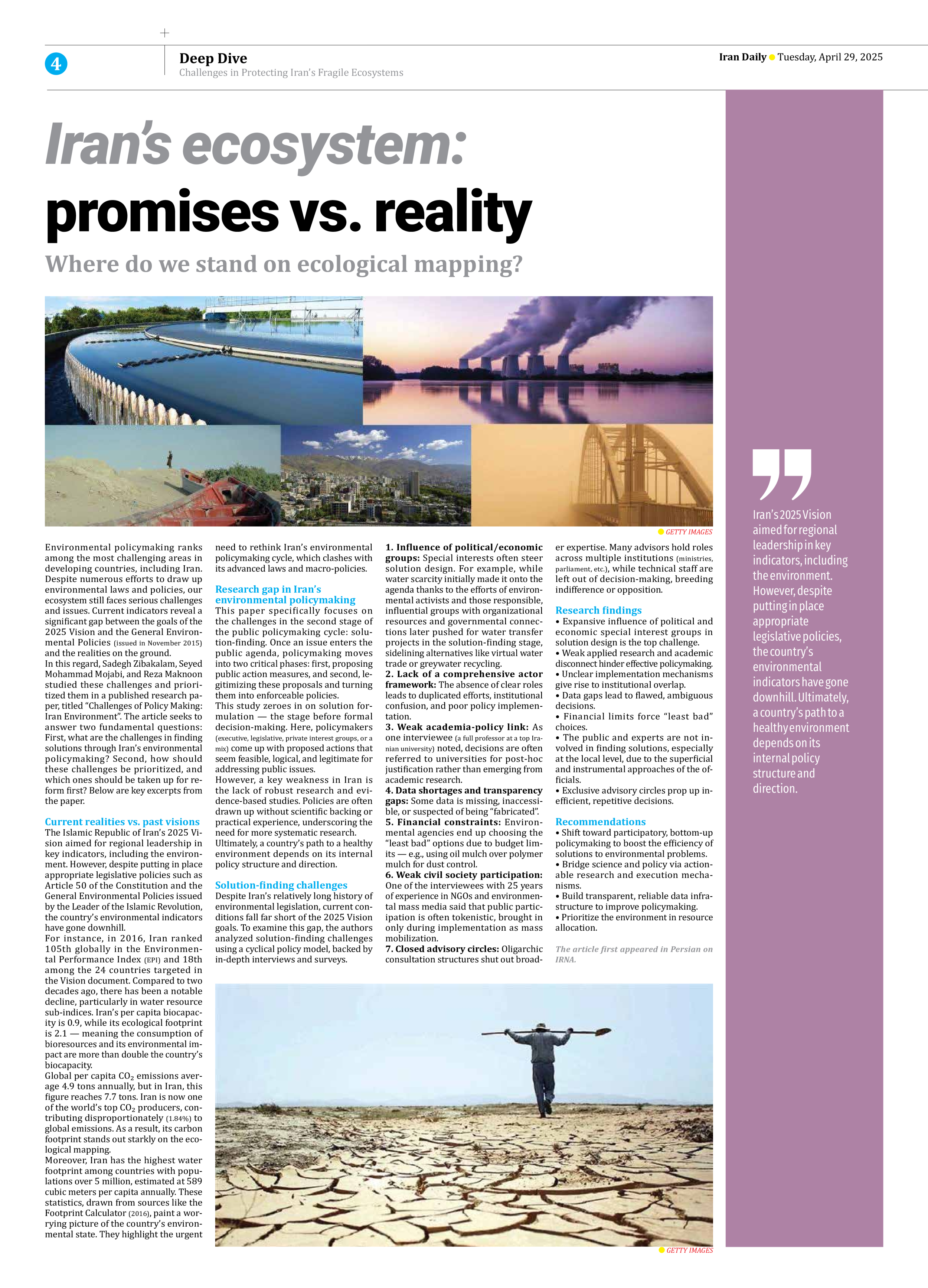
Iran’s ecosystem: promises vs. reality
Where do we stand on ecological mapping?
Environmental policymaking ranks among the most challenging areas in developing countries, including Iran. Despite numerous efforts to draw up environmental laws and policies, our ecosystem still faces serious challenges and issues. Current indicators reveal a significant gap between the goals of the 2025 Vision and the General Environmental Policies (issued in November 2015) and the realities on the ground.
In this regard, Sadegh Zibakalam, Seyed Mohammad Mojabi, and Reza Maknoon studied these challenges and prioritized them in a published research paper, titled “Challenges of Policy Making: Iran Environment”. The article seeks to answer two fundamental questions: First, what are the challenges in finding solutions through Iran’s environmental policymaking? Second, how should these challenges be prioritized, and which ones should be taken up for reform first? Below are key excerpts from the paper.
Current realities vs. past visions
The Islamic Republic of Iran’s 2025 Vision aimed for regional leadership in key indicators, including the environment. However, despite putting in place appropriate legislative policies such as Article 50 of the Constitution and the General Environmental Policies issued by the Leader of the Islamic Revolution, the country’s environmental indicators have gone downhill.
For instance, in 2016, Iran ranked 105th globally in the Environmental Performance Index (EPI) and 18th among the 24 countries targeted in the Vision document. Compared to two decades ago, there has been a notable decline, particularly in water resource sub-indices. Iran’s per capita biocapacity is 0.9, while its ecological footprint is 2.1 — meaning the consumption of bioresources and its environmental impact are more than double the country’s biocapacity.
Global per capita CO₂ emissions average 4.9 tons annually, but in Iran, this figure reaches 7.7 tons. Iran is now one of the world’s top CO₂ producers, contributing disproportionately (1.84%) to global emissions. As a result, its carbon footprint stands out starkly on the ecological mapping.
Moreover, Iran has the highest water footprint among countries with populations over 5 million, estimated at 589 cubic meters per capita annually. These statistics, drawn from sources like the Footprint Calculator (2016), paint a worrying picture of the country’s environmental state. They highlight the urgent need to rethink Iran’s environmental policymaking cycle, which clashes with its advanced laws and macro-policies.
Research gap in Iran’s environmental policymaking
This paper specifically focuses on the challenges in the second stage of the public policymaking cycle: solution-finding. Once an issue enters the public agenda, policymaking moves into two critical phases: first, proposing public action measures, and second, legitimizing these proposals and turning them into enforceable policies.
This study zeroes in on solution formulation — the stage before formal decision-making. Here, policymakers (executive, legislative, private interest groups, or a mix) come up with proposed actions that seem feasible, logical, and legitimate for addressing public issues.
However, a key weakness in Iran is the lack of robust research and evidence-based studies. Policies are often drawn up without scientific backing or practical experience, underscoring the need for more systematic research.
Ultimately, a country’s path to a healthy environment depends on its internal policy structure and direction.
Solution-finding challenges
Despite Iran’s relatively long history of environmental legislation, current conditions fall far short of the 2025 Vision goals. To examine this gap, the authors analyzed solution-finding challenges using a cyclical policy model, backed by in-depth interviews and surveys.
1. Influence of political/economic groups: Special interests often steer solution design. For example, while water scarcity initially made it onto the agenda thanks to the efforts of environmental activists and those responsible, influential groups with organizational resources and governmental connections later pushed for water transfer projects in the solution-finding stage, sidelining alternatives like virtual water trade or greywater recycling.
2. Lack of a comprehensive actor framework: The absence of clear roles leads to duplicated efforts, institutional confusion, and poor policy implementation.
3. Weak academia-policy link: As one interviewee (a full professor at a top Iranian university) noted, decisions are often referred to universities for post-hoc justification rather than emerging from academic research.
4. Data shortages and transparency gaps: Some data is missing, inaccessible, or suspected of being “fabricated”.
5. Financial constraints: Environmental agencies end up choosing the “least bad” options due to budget limits — e.g., using oil mulch over polymer mulch for dust control.
6. Weak civil society participation: One of the interviewees with 25 years of experience in NGOs and environmental mass media said that public participation is often tokenistic, brought in only during implementation as mass mobilization.
7. Closed advisory circles: Oligarchic consultation structures shut out broader expertise. Many advisors hold roles across multiple institutions (ministries, parliament, etc.), while technical staff are left out of decision-making, breeding indifference or opposition.
Research findings
• Expansive influence of political and economic special interest groups in solution design is the top challenge.
• Weak applied research and academic disconnect hinder effective policymaking.
• Unclear implementation mechanisms give rise to institutional overlap.
• Data gaps lead to flawed, ambiguous decisions.
• Financial limits force “least bad” choices.
• The public and experts are not involved in finding solutions, especially at the local level, due to the superficial and instrumental approaches of the officials.
• Exclusive advisory circles prop up inefficient, repetitive decisions.
Recommendations
• Shift toward participatory, bottom-up policymaking to boost the efficiency of solutions to environmental problems.
• Bridge science and policy via actionable research and execution mechanisms.
• Build transparent, reliable data infrastructure to improve policymaking.
• Prioritize the environment in resource allocation.
The article first appeared in Persian on IRNA.







